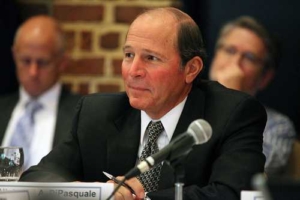Nick DiPasquale led the EPA Chesapeake Bay Program Office (CBPO) for six and a half years, making him the second-longest serving director of the program. DiPasquale came on as Director in August 2011, and served in that role until this past December, when he retired. On why he was drawn to the position, he said, “it is a comprehensive, eco-system based program dealing with the totality of the environment – fisheries, habitat, water quality, land conservation, toxic substances, land use, toxic substances, climate resiliency, environmental literacy, citizen stewardship, etc.”

DiPasquale at an Executive Council meeting
DiPasquale was in charge of overseeing the large restoration effort of the Chesapeake Bay watershed. Under Section 117 of the Clean Water Act, the CBPO is responsible for providing support for the Chesapeake Executive Council which is made up of the Governors of the 6 states in the watershed, the Mayor of the District of Columbia, the Chair of the Chesapeake Bay Commission and the EPA Administrator representing the federal government. The CBPO also coordinated the efforts of approximately 12 federal agencies in supporting the states’ restoration efforts. It is responsible for coordinating science, research, modeling, support services, monitoring, data collection and other activities to support the restoration effort.
DiPasquale says that one of the most important projects he worked on was the development and enactment of the 2014 Chesapeake Bay Watershed Agreement. This effort involved a major re-write of the voluntary agreements that have guided the Program since 1983. It incorporated the three “headwater” states of West Virginia, New York and Delaware as full partners in the restoration effort. It also aligned all of the goals and outcomes contained in previous Bay agreements, the President’s 2009 Executive Order and the Clean Water Act Total Maximum Daily Load (TMDL). The 2014 Agreement created a new management and accountability system which included the development of management strategies for each of the 31 outcomes, biennial workplans, as well as a strategy review system that ensures CBPO stays on track as they implement actions in the workplans, assess whether progress is being made by evaluating the data and whether the indicators show whether they are making progress, and, if not, whether they need to change their actions to achieve progress. The 2014 Watershed Agreement provides the operating plan that will govern the CBPO’s actions and progress toward their collective goals until 2025.
One of DiPasquale’s favorite projects was supporting the adoption of high resolution land cover data (1 meter resolution) into the Chesapeake Bay model to more accurately reflect what is happening on the ground as land uses change over time. It helps the team better understand the sources of pollution and how best to reduce pollution loading to the watershed. He also worked to support the development of a Citizens’ Monitoring program. Many environmental organizations and watershed groups have developed sophisticated water quality and biological monitoring programs that meet the rigorous standards for quality assurance and quality control that are required by the Bay Program. They wanted to ensure that the data generated by these organizations could be utilized by the Program to supplement their own expansive monitoring network. It allows them to get information in parts of the watershed where they did not have monitoring stations. On the importance of this project, Nick said, “This data is extremely helpful in understanding the watershed, and accepting this data from these programs also builds support for the Program at the local level.”
“One of the most rewarding parts of the job was witnessing the progress we have made over the past 30 years in the results of the indicators we used to measure the health of the watershed,” DiPasquale said. Blue crab and underwater grass populations, water quality and clarity, and species richness have all increased over that time. The ecosystem is starting to recover from centuries of misuse, and he is thrilled by the current progress in the face of other environmental challenges. In his retirement, he said he “plans to continue to stay engaged in efforts to restore this important ecosystem,” but while also spending more time on the Bay as well. He plans on kayaking and traveling more, and teaching a few courses at Washington College on environmental policies and management. Please join us in thanking him for his commitment to Bay restoration and all of his achievements in his role as CBPO Director. We wish you the best, Nick!
